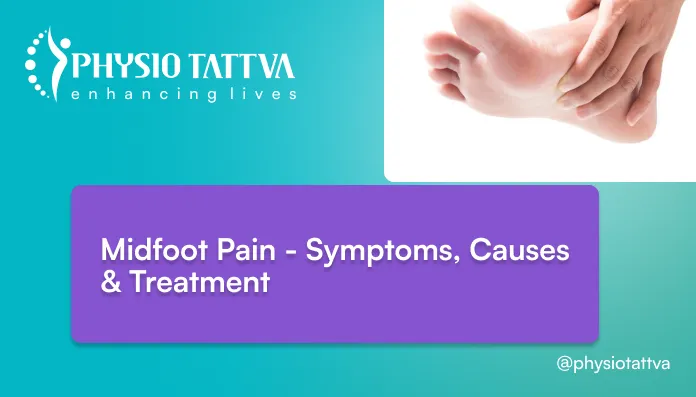All About Midfoot pain
Are you tired of dealing with a dull ache, especially in the middle of your foot, after your morning walks? If you have noticed this pain increase with age, it may be a sign of an underlying condition or injury. Regardless of the condition, seeking expert guidance is essential to end such discomfort.
Causes for Midfoot pain
Wear and tear of muscles and joints due to repetitive movements, injuries, sudden pressure, or overexertion can negatively impact the foot leading to pain. Although common among elders, we are all susceptible to this condition.
Midfoot sprains or fractures
Midtarsal joint sprain or fracture to the ligaments holding the tarsal bones located at the middle of the foot can result in mild to severe pain. This is especially common among athletes as they overexert their bodies. The rare occurrence of a tarsal fracture in the rear of the foot can also lead to this condition. Such injuries increase the risk of acute fractures or stress fractures.
Arthritis
Different types of arthritis can lead to midfoot pain. These include osteoarthritis, posttraumatic arthritis, rheumatoid arthritis, or psoriatic arthritis. A gradual decay signifies osteoarthritis in the cartilage covering the joints. As a result, repeated friction between joints leads to pain and inflammation. In posttraumatic arthritis, an injury that causes damage to the cartilage or joint surface aggravates the symptoms of the former condition leading to severe pain. Finally, rheumatoid arthritis and psoriatic arthritis are autoimmune conditions that negatively impact the joints, cartilage, and tendons leading to irreversible damage.
Plantar fasciitis
One of the most common causes of midfoot pain is plantar fasciitis. This condition is characterized by an inflammation of the thick band of tissue that runs along the bottom of each foot. It connects the heel bone to the toes. Damage to these tissues leads to stabbing pain. It is commonly observed among runners and overweight people.
Tendinitis or tendinosis
Tendonitis is inflammation of the thick fibrous connective tissues that attach muscles to the bones. This results in pain and inflammation in the joints. People engaging in strenuous physical activity or repetitive movements are more likely to be vulnerable to this condition.
Overuse injuries
As mentioned, repetitive movements or wear and tear of one particular muscle/joint can lead to severe damage. Overuse injuries in the midfoot commonly lead to joint pain, tendinitis, and stress fractures.
Flat feet or high arches
Fallen arches or a flat foot cannot support your feet. This results in overstretched tendons and severe midfoot pain. On the other hand, high arches add pressure to the metatarsals or midfoot bone, leading as you walk, run, or stand, leading to pain.
Symptoms for Midfoot pain
Any injury or sprain on the midfoot is detected by factors other than pain. These symptoms may vary in intensity, causing mild to severe discomfort as you engage in daily activities.
Pain and tenderness in the midfoot region
Basic activities like walking or standing can cause severe pain and tenderness in the midfoot. This is commonly caused by the degree of pressure exerted in this region. Depending on the kind of injury or condition, you may experience these symptoms in different intensities.
Swelling and inflammation
In specific conditions like arthritis, experiencing swelling or inflammation is common. Physicians tend to examine the affected area for swelling or discoloration to understand the degree of pain or the nature of the underlying condition.
Walking Difficulty or bearing weight on the affected foot
Regardless of dull or sharp pain, the pressure exerted on the midfoot can make walking or bearing weights difficult. Throughout the day, applying excessive pressure can increase swelling and pain. Further, intense physical activities can weaken the midfoot ligaments, leading to serious injuries and midfoot pain.
Stiffness or limited range of motion
If ignored, the symptoms of midfoot pain can worsen and limit your range of motion. For conditions like tendonitis, plantar fasciitis, sprains, and more, the wear and tear of muscles and joints result in stiffness and pain. This is commonly why physicians observe your range of motion or conduct physical examinations to understand the degree of stiffness in your midfoot.
Treatment for Midfoot pain
We understand that these symptoms may be overwhelming to deal with. However, our experts recommend several treatment techniques to help ease the pain and achieve complete recovery.
Rest, ice, compression, and elevation (RICE)
The RICE method is one of the most prominent coping strategies, providing instant relief from pain and stiffness:
- It is essential to rest the foot during the initial days of injury.
- Wrapping an ice pack in a towel and placing it on the midfoot for at least 20 minutes can help ease inflammation.
- Compression and elevation involve wrapping the injured foot in elastic bandages and raising it on pillows for regular circulation and to minimize swelling.
Nonsteroidal anti-inflammatory drugs (NSAIDs)
Muscle relaxants, pain relievers, and other nonsteroidal anti-inflammatory drugs (NSAIDs) can help reduce inflammation, stiffness, and pain in the midfoot. These medications are prescribed by physicians based on the intensity of the pain. However, medications are not sufficient for making a complete and long-term recovery.
Physical therapy and rehabilitation exercise
Stretching and strengthening exercises, combined with alternative physiotherapy techniques that include massages, chiropractic care, acupuncture, and more, can reduce pain and promote a complete recovery. These exercises aim to improve circulation and strength in the midfoot while reducing the degree of swelling or tightness. As you progress, your physiotherapist may increase the intensity of exercises to promote the range of motion.
Custom orthotics or shoe inserts
Medical devices (orthotics) placed inside your shoes can readjust mechanical issues of your foot that impair basic activities like walking, standing, or running. For conditions like diabetes, bursitis, plantar fasciitis, and arthritis, the use of orthotics shows long-term benefits. Further, gel, plastic, or foam inserts can be bought at any medical store and can also be used to provide cushioning and support to your midfoot.
Surgery (in severe cases)
In severe cases, foot fusion surgeries can be an effective approach to treating mid-foot pain. Research has indicated that for specific conditions like fractures, arthritis, or flat feet, the surgery helps fuse separated bones in the midfoot. The benefits of this surgery are not limited to pain relief. It also helps improve functionality and strengthens the midfoot.
Physiotherapy Treatment for Midfoot Pain
After conducting a comprehensive assessment of your condition, the physiotherapist may suggest different forms of physical therapy to overcome midfoot pain. These can include conventional methods (exercises) or alternative treatments (acupuncture).
Manual Therapy
Manual therapy is a specialized, hands-on approach to treatment where the professional puts pressure on the tissues and readjusts joints. The techniques target soft tissues and reduce midfoot spasms, pain, inflammation, or tightness.
Exercise Therapy
Based on the injury or condition, your physiotherapist may recommend various forms of exercise therapy. This modality aims to improve the range of motion, coordination, and balance and to relax muscles. Different types of exercise therapy include balance, strengthening, resistance, and stretching exercises.
Gait Training
Various techniques of gait training help alleviate symptoms of midfoot pain, including balance and motor coordination issues. Range of motion, lower extremity strengthening, obstacle gait training, and proprioception exercises are recommended by experts.
Custom Orthotics
Experts will likely suggest orthotics if the symptoms are caused by flat feet or high arches. These devices support the foot and prevent excessive pressure on the joints. With the cushioning provided by orthotics, you can overcome pain or discomfort.
How Physiotattva helps in Midfoot pain relief?
At Physiotattva, we prioritize treatment plans that meet your needs. You can overcome any physiological concern from massages, electrotherapy, heat and cold therapy, chiropractic care, aqua therapy, and more. We aim to alleviate midfoot pain and provide long-term benefits that protect you from potential injuries. If you are struggling with the distressing symptoms of this condition, reach out to our experts at +91 89510 47001.
Frequently Asked Questions
What are the common causes of midfoot pain?
Several factors can lead to midfoot pain, including-
- Overuse injuries
- Tendonitis
- Plantar fasciitis
- Arthritis
- Sprains
- Metatarsal fractures
Can midfoot pain be treated with physiotherapy?
Physical therapy has proven to be one of the most effective treatment approaches for midfoot pain. You can recover completely with manual exercises, massages, electrotherapy, acupuncture, chiropractic care, and heat and cold therapy.
What does a physiotherapy session for midfoot pain involve?
A physiotherapy session for midfoot pain involves a comprehensive assessment. The expert designs a customizable treatment plan that includes exercises and alternative techniques to improve balance, motor coordination, circulation, strength, and range of motion.





.webp)
.webp)

-min.webp)

